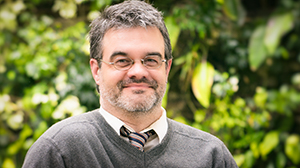

Considering the site today has to do with more than just history, it has to do with social justice.”
The Lakeshore Psychiatric Hospital Cemetery has a long and important history in Etobicoke, but the site and the hundreds buried there once seemed in danger of fading completely from memory. That’s part of what motivated University of Guelph-Humber sessional instructor and historian Dr. Gregory Klages and others to help ensure the hospital, cemetery, and the patients permanently resting there are not forgotten.
Dr. Klages recently explored the site’s history in a public talk as part of the Ontario Genealogical Society’s 2017 Toronto History Lecture Series.
Dr. Klages sees the cemetery not just as an interesting part of the city’s history, but also as a valuable lesson in the history of Toronto’s treatment of marginalized people.
“How can we use information about this site and the history of the hospital to talk about mental health issues today?” Dr. Klages asks.
The Lakeshore Psychiatric Hospital operated from 1889 until 1979. Within a decade of the hospital closing, the cemetery – which had its last burial in 1974 – had become overrun with knee-high grass, fallen trees and litter, and some of the flat headstones had been overgrown with sod. During the 1990s, development of the site was approved. These plan were overturned by the provincial government in 2007.
For over a decade, psychiatric survivors, historians and others interested in the site have worked hard to care for the site and commemorate the people buried there. In 2012, the provincial government erected signage and a plaque detailing the cemetery’s history.
Still, Dr. Klages – who is also the author of the best-selling The Many Deaths of Tom Thomson: Separating Fact from Fiction – was interested in finding out more about the people buried in the cemetery. Though more than 1,500 people were buried at the cemetery, there are only headstones for fewer than 200 of the interred. In some cases, multiple people (including children) were buried in the same graves. There is also suspicion that some of the interred people were not hospital patients.
Using a Research grant from the University of Guelph-Humber, as well as funding from Toronto’s Centre for Addiction & Mental Health Archives, Dr. Klages began combing through old hospital and provincial government records to try to learn more about the people buried at the cemetery. He has reviewed over 1,000 pages of hand-written patient records, and with help from a UofGH undergraduate research assistant, he is writing and digitizing biographical information concerning the people buried there.
He points out that many of the patients at the hospital worked a 100-acre farm in Etobicoke. He feels that those patients were pioneers who deserved better than being forgotten.
“They are a significant population who, by virtue of the time they lived in and the understanding of mental health, ended up in circumstances most of us would see as lamentable: being buried in a grave that for a long time was forgotten and not maintained,” he said. “Those people just slid off the radar. It’s tragic.”
While attitudes toward mental health have changed, Dr. Klages sees the cemetery as a meaningful reminder of our not-so-distant past.
“Considering the site today has to do with more than just history, it has to do with social justice,” Dr. Klages observes.







